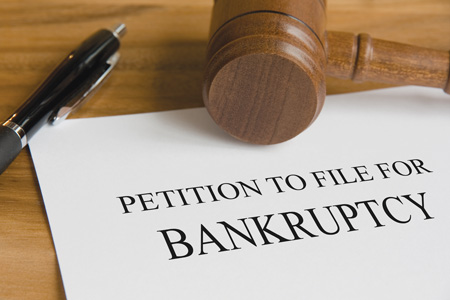|
||
|
 |
Filing for bankruptcy is a humbling experience, but it's one that can save your business if you do it right. |
If you're insolvent and can't pay bills as they come, if a bank is moving against your assets and if you feel you don't have time to mitigate such problems, consider filing for bankruptcy.
Chapter 11 bankruptcy provides the protection of reorganizing a business while running it. Individuals file for bankruptcy under Chapter 13. Chapter 7 bankruptcy, on the other hand, usually means a business is over - it closes its locations and a trustee takes over the business to liquidate its assets through an auction. Filing under Chapter 11 and/or Chapter 13 can provide you with protection necessary to push the restart button on your business and give it a fresh start.
Before you file for bankruptcy protection consider the following advice from Nat Wasserstein, owner of Lindenwood Associated LLC, a business crisis management firm in Upper Nyack, New York:
Restructure Out of Court
Before filing for bankruptcy, do what you can to restructure your business outside of court to prevent filing. Talk to your lender. You may be able to refinance or modify your loan or to arrange a forbearance agreement, or a contract that obligates the lender to temporarily refrain from enforcing existing and anticipated defaults and from going after the borrower's assets.
If you owe money to vendors, explain your situation and try to arrange a payment plan. Before you meet with them do your homework. Determine how much you've paid them over the years you've done business with them. Tell them, for example, that you paid them $1.5 million over the last 20 years, and they may never see the $60,000 you owe them if your company files for bankruptcy. "Once they see the downside is huge they'll be willing to negotiate," Wasserstein says.
Consider Cost and Risks
Bankruptcy is expensive. In addition to a filing fee you'll also have to pay lawyers' fees and that could be as much as $50,000 to $150,000, Wasserstein says. And don't forget that filing for bankruptcy means you may lose business and compromise relationships with customers, suppliers and vendors. Suppliers might not want to agree to your terms. Customers might not want to do business with a company that could shut its doors in the near future, or buy products that have a warranty that may not be good down the road.
Make sure you have as much cash on hand as possible before filing for bankruptcy. "You don't want to run into a situation where you're administratively insolvent," Wasserstein says, meaning you can't pay for bankruptcy.
Consider Personal Bankruptcy Protection
If your home, taxes and personal finances are being deeply affected, you might want to consider filing for personal bankruptcy protection under Chapter 13, in addition to Chapter 7 or Chapter 11 bankruptcy, to protect your assets. Many SBA loans, for example, have a personal guarantee that allows lenders to go after the business owner's home and other assets in the event of insolvency. Chapter 13 can prevent lenders from acting against you.
Of course, you should consult an attorney to see what your options are and what type of bankruptcy protection makes the most sense for your business. While bankruptcy comes with a stigma, it can also be used as a tool to fix the balance sheet up, Wasserstein says.
BANKRUPTCY 101: WHAT YOUR BUSINESS SHOULD KNOW

The term bankruptcy first appeared in 1543 and is derived from the Latin words "bancus" and "ruptus," which translates to "broken table." In Medieval Roman times, traders would destroy the tables that they used to conduct their trade when business went bad and they wished to demonstrate their intent to discontinue the business. Modern bankruptcy law has evolved considerably and can be an important tool for small businesses in today's challenging economic environment.
Types
Bankruptcy assists financially distressed debtors by encouraging a debtor's "fresh start," while simultaneously protecting creditors. There are six different types of bankruptcy. Most small businesses typically pursue either chapter 7 or chapter 11 protection. Chapter 11 reorganizations usually involve corporate debtors. A business may wish to file for chapter 11 protection where they do not pass the Bankruptcy Code's "means test" under chapter 7, and the debtor wishes to maintain control over assets.
Procedure
The bankruptcy process kicks off when a debtor files a bankruptcy petition. In general, upon filing the petition, an estate containing debtor's assets is created, an automatic stay is implemented, a Trustee is appointed to administer the estate, and creditors receive a claim in the bankruptcy proceeding.
Some of debtor's assets are exempt from the estate and can be retained, including allowances for equipment or tools used on the debtor's job, and the debtor's home and motor vehicle. The automatic stay operates as an injunction and prevents creditors from taking any action to collect on the debt. A Trustee manages the bankruptcy estate assets, decides whether to avoid contracts or liens, and helps plan the ultimate disposition of those assets to creditors.
Each creditor receives a claim upon the bankruptcy filing, but certain claims are entitled priority over others. Priority debt, such as claims for child support or alimony, must be paid before all other types of debt. Additionally, certain types of debt are dischargeable. Unlike unsecured debt, priority debt and secured debt are not dischargeable. A lien that has not been avoided in the bankruptcy case survives the bankruptcy and secured creditors can still enforce the lien.
Bankruptcy law implements both pro-debtor and pro-creditor policies that are important for your small business to know about.
